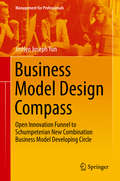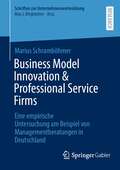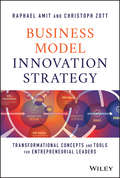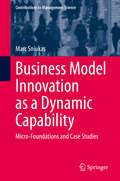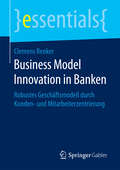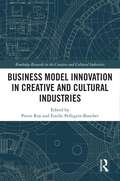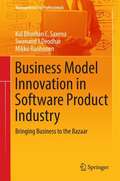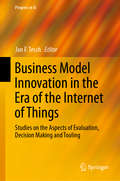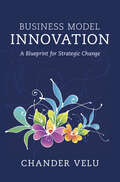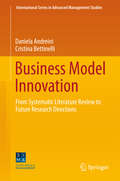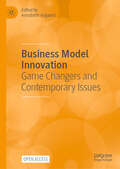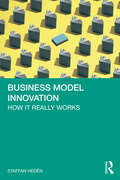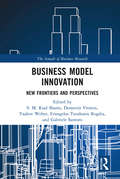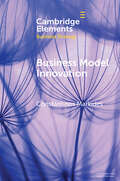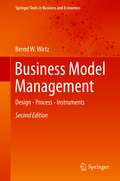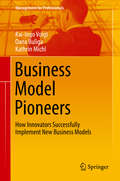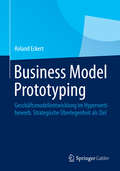- Table View
- List View
Business Model Design Compass: Open Innovation Funnel to Schumpeterian New Combination Business Model Developing Circle (Management for Professionals)
by Jinhyo Joseph YunThis book reveals how open innovation utilizes the developing circle of business models to establish new ones that define a unique link between technology and markets, focusing on how to develop and maintain successful business models. It draws readers into the philosophy and economic effects of open innovation from the outset. It presents four different developing circle business models for customers in the role of consumers, entrepreneurs, social entrepreneurs and engineers respectively, enabling each group to develop, utilize and enlarge creative business models, and even switch business models. In addition to these four circles, it takes a systemic approach to describe the relationship between technology and markets. From this relationship an open innovation strategy towards entrepreneurship can be adopted. From Open Innovation to a Creative Developing-Circle Business Model is an essential resource for start-up entrepreneurs, as well as for students of technology management, strategy and open innovation.
Business Model Generation: A Handbook for Visionaries, Game Changers, and Challengers (The Strategyzer Series #1)
by Yves Pigneur Alexander OsterwalderBusiness Model Generation is a handbook for visionaries, game changers, and challengers striving to defy outmoded business models and design tomorrow's enterprises. If your organization needs to adapt to harsh new realities, but you don't yet have a strategy that will get you out in front of your competitors, you need Business Model Generation.Co-created by 470 "Business Model Canvas" practitioners from 45 countries, the book features a beautiful, highly visual, 4-color design that takes powerful strategic ideas and tools, and makes them easy to implement in your organization. It explains the most common Business Model patterns, based on concepts from leading business thinkers, and helps you reinterpret them for your own context. You will learn how to systematically understand, design, and implement a game-changing business model--or analyze and renovate an old one. Along the way, you'll understand at a much deeper level your customers, distribution channels, partners, revenue streams, costs, and your core value proposition.Business Model Generation features practical innovation techniques used today by leading consultants and companies worldwide, including 3M, Ericsson, Capgemini, Deloitte, and others. Designed for doers, it is for those ready to abandon outmoded thinking and embrace new models of value creation: for executives, consultants, entrepreneurs, and leaders of all organizations. If you're ready to change the rules, you belong to "the business model generation!"
Business Model Innovation & Professional Service Firms: Eine empirische Untersuchung am Beispiel von Managementberatungen in Deutschland (Schriften zur Unternehmensentwicklung)
by Marius SchramböhmerMarius Schramböhmer zeigt detailliert die Bedeutung der Professional Service Firms (PSF), spezifischer noch der Unternehmensberatungen und des Subtypus der Managementberatung auf. Dabei adressiert er die auf die Branche einwirkenden Kräfte und die hieraus resultierenden Veränderungen der etablierten Geschäftsmodelle. Durch die Einnahme einer konsequenten PSF-Perspektive wird das Forschungsfeld zu Geschäftsmodellen und Geschäftsmodellinnovationen systematisch aufgearbeitet sowie theoretisch und empirisch ein spezifisch für PSFs geeignetes Geschäftsmodell-Konstrukt hergeleitet. Entlang der komplexen Verknüpfungen der einzelnen Dimensionen werden strategische Gruppen mit spezifischen Geschäftsmodellen im Kontext des Innovationsgrades aufgezeigt und diskutiert.
Business Model Innovation Strategy: Transformational Concepts and Tools for Entrepreneurial Leaders
by Raphael Amit Christoph ZottThe most comprehensive, global guide to business model design and innovation for academic and business audiences. Business Model Innovation Strategy: Transformational Concepts and Tools for Entrepreneurial Leaders is centered on a timely, mission-critical strategic issue that both founders of new firms and senior managers of incumbent firms globally need to address as they reimagine their firms in the post COVID-19 world. The book, which draws on over 20 years of the authors collaborative theoretical and rigorous empirical research, has a pragmatic orientation and is filled with examples and illustrations from around the world. This action-oriented book provides leaders with a rigorous and detailed guide to the design and implementation of innovative, and scalable business models for their companies. Faculty and students can use Business Model Innovation Strategy as a textbook in undergraduate, MBA, and EMBA degree courses as well as in executive courses of various designs and lengths. The content of the book has been tested in both degree and non-degree courses at some of the world's leading business schools and has helped students and firm leaders to develop ground-breaking business model innovations. This book will help you: Learn the basics of business model innovation¯including the latest developments in the field Learn how business model innovation presents new and profitable business opportunities in industries that were considered all but immune to attacks from newcomers Learn how to determine the viability of your current business model Explore new possibilities for value creation by redesigning your firm's business model Receive practical, step-by-step guidance on how to introduce business model innovation in your own company Become well-versed in an important area of business strategy and entrepreneurship Authors Amit and Zott anchored the book on their pioneering research and extensive scholarly and practitioner-oriented publications on the design, implementation, and performance implications of innovative business models. They are the most widely cited researchers in the field of business model innovation, and they teach at the top-ranked Wharton School of the University of Pennsylvania and the prestigious global business school IESE with campuses in Barcelona, Madrid, Munich, New York, and São Paulo.
Business Model Innovation as a Dynamic Capability: Micro-Foundations and Case Studies (Contributions to Management Science)
by Marc SniukasThis study adopts a dynamic capabilities perspective to explore the activities and processes through which business model innovations arise in established organisations. New and innovative business models are fundamental to the commercialisation of the latest technologies, performance, and competitive advantage, as well as value creation for customers, the focal company and its ecosystem. Yet, our current understanding of how established companies design and implement new business models is limited by a lack of empirical research. Based on a review of relevant literature, business model innovation is presented and explored as a dynamic capability.The book subsequently uses proven methodologies to gather and analyse data from five case studies in the manufacturing, financial services, media, consulting, and healthcare industries. The framework developed here offers a novel understanding of how business model innovations come about in established organisations, a practice it dubs ‘crafting business models in statu nascendi’.
Business Model Innovation for Energy Transition: A Path Forward Towards Sustainability (Palgrave Studies in Democracy, Innovation, and Entrepreneurship for Growth)
by Milton M. HerreraThis book presents a dynamics model-based perspective for attaining the energy transitions by business model innovation. It examines how dynamic business modelling and innovation studies can assist in the sustainability transitions field, highlighting the role of technological innovation system (TIS) and dynamic performance management (DPM). In the last decade, renewables have operated in the context of emerging societal transitions. Indeed, one of the current challenges for the energy sector is to transform business models in tune with shifting societal and market conditions. This work shows how dynamic business modelling captures the feedback loops and the behaviour of performance measures to contribute the energy transitions. Besides, this book offers an in-depth discussion on innovation measurement to designing index of green technology, which it will prove useful to those studying management sciences, energy, innovation, and sustainability.
Business Model Innovation in Banken: Robustes Geschäftsmodell durch Kunden- und Mitarbeiterzentrierung (essentials)
by Clemens RenkerWie und in welche Richtung sich das traditionelle Gesch#65533;ftsmodell von Banken in Zukunft ver#65533;ndern muss, behandelt dieses essential. Clemens Renker zeigt, dass Kreditinstitute die neuen Herausforderungen nicht mehr allein mit Erhaltungspolitik, Anpassungspolitik oder Produkt- und Prozessinnovationen bew#65533;ltigen werden. Agilit#65533;t und strategische Flexibilit#65533;t sind die gefragten Kernkompetenzen, um eine Bank in ihrer Existenz zu sichern und Zukunftssicherheit zu gestalten. Es braucht ,,Neoretiker", also Erneuerer, Transformatoren oder Change Manager, die ein tragf#65533;higes, zuk#65533;nftiges Bankwesen gestalten k#65533;nnen.
Business Model Innovation in Creative and Cultural Industries (Routledge Research in the Creative and Cultural Industries)
by Pierre Roy Estelle Pellegrin-BoucherBusiness model innovation occurs when an organization discovers a new way of creating revenues or profits via its products or services. This book examines the concept as it applies across the creative and cultural industries in practice.This book examines market, social and political environments which impact creative and cultural organizations' business models, such as sustainability, new forms of competition, digitalization and data management, emerging technologies like AI, and shifting social trends and lifestyles. This book not only analyses these influences but also presents best practices, key success factors, and compelling case studies. Employing a case study format, a range of creative or cultural sectors are analysed, including fashion, architecture and gaming.The result is a book which delivers value for researchers, advanced students, and reflective practitioners involved in the creative economy around the world.
Business Model Innovation in Software Product Industry
by Kul Bhushan C. Saxena Swanand J. Deodhar Mikko RuohonenThis book examines the current massive changes in the software product industry on the basis of business model changes affecting six software products, and proposes a generic framework for business model innovation. Due to the combined effects of globalization, new market expectations and IT consumerization, the software industry has been experiencing a period of fundamental and rapid change. Achieving agility and the ability to innovate has now become vital, thus forcing organizations to create immense potential for innovating their business models. Proprietary and open source software (OSS) licensing represent the two extreme ends of the spectrum that could be used to build the business model of a software product. Given the changed face of the software product industry, successful software product vendors are innovating their business models by adopting a variety of combinations of these unilateral and new business models. However, these innovations also pose a number of challenges. The book examines these challenges in the context of several software product case studies in which companies successfully (or in some cases, less successfully) met these challenges and changed their business models. Focusing on the major issues related to business models in the software product industry, the book is targeted for a variety of readers: software entrepreneurs/start-ups, software product industry professionals, academics and students. Though the industry and technologies are changing rapidly, the issues addressed here are fundamental and will remain important ones for the foreseeable future.
Business Model Innovation in the Era of the Internet of Things: Studies On The Aspects Of Evaluation, Decision Making And Tooling (Progress in IS)
by Jan F. TeschThis book outlines an integrative framework for business-model innovation in the paradigm of the Internet of Things. It elaborates several tools and methodologies for the quantitative, qualitative, analytical and effectual evaluation, and analyzes their applicability and efficiency for several phases of the business-model innovation process. As such, it provides guidance to managers, decision-makers and entrepreneurs on how to systematically employ the business-model concept with the aim of achieving sustainable competitive advantages. For researchers the book introduces cases and examples for successful business-model innovation and presents an integrated approach to the methods and tools applied.
Business Model Innovation: A Blueprint for Strategic Change
by Chander VeluWhat strategic challenges are faced by both start-ups and incumbent firms, and what opportunities do these challenges create for business model innovation? Focusing on the underpinning theory and concepts of business models, this book identifies new business models capable of creating sustainable competitive advantage, and guides readers through their implementation. A detailed introduction outlines current research in business model innovation (including directions for future research) and global business cases are applied throughout to illustrate key issues. Topics covered include market creation, leadership, digital technology adoption, small- and medium-sized enterprises, start-ups, sustainability, socio-economic development and conduct risk. Also discussed are the principles of the architecting economic systems, the role of government in influencing business models design, and how organisational 45structures must adapt in the context of business model innovation.
Business Model Innovation: Concepts, Analysis, and Cases
by Allan AfuahRooted in strategic management research, Business Model Innovation explores the concepts, tools, and techniques that enable organizations to gain and/or maintain a competitive advantage in the face of technological innovation, globalization, and an increasingly knowledge-intensive economy. The book investigates how organizations can use innovations in business models to take advantage of entrepreneurial opportunities from: * Crowdsourcing and open innovation * Long Tails * Social media * Disruptive technologies * Less-is-more innovations * Network effects * Scarcity of complementary capabilities The book also looks at the ways firms can use innovations in business models to exploit or defend against threats. With twelve supplementary cases to help readers apply the concepts and techniques, this book is a must-have for anyone looking to understand the fundamentals of business model innovation.
Business Model Innovation: Concepts, Analysis, and Cases
by Allan AfuahRooted in strategic management research, Business Model Innovation explores the concepts, tools, and techniques that enable organizations to gain and/or maintain a competitive advantage in the face of technological innovation, globalization, and an increasingly knowledge-intensive economy. Updated with all-new cases, this second edition of the must-have for those looking to grasp the fundamentals of business model innovation, explores the novel ways in which an organization can generate, deliver, and monetize benefits to customers.
Business Model Innovation: From Systematic Literature Review to Future Research Directions (International Series in Advanced Management Studies)
by Daniela Andreini Cristina BettinelliThis book presents a systematic literature review of 156 published papers on business model innovation (BMI). The aim is to identify and integrate the different theoretical perspectives, analytical levels, and empirical contexts in order to deepen understanding of this complex phenomenon. The authors conduct an inductive thematic analysis based on an informal ontological classification that identifies 56 key themes. Within each theme, discussion focuses on thematic patterns, potential inconsistencies and debates, and future directions and opportunities for research. The book makes a number of significant contributions to the field. First, it offers a deeper understanding of the evolution of research on BMI through an ontological map that identifies the key thematic areas in the literature. Second, a multilevel model is developed that clarifies the concept of BMI by identifying its drivers, contingencies, and outcomes. Third, the authors identify clear and specific directions for further research and offer suggestions on research design, creating an informative road map for the future. The book will be of value both to scholars and researchers and to practitioners.
Business Model Innovation: Game Changers and Contemporary Issues
by Annabeth AagaardIn the contemporary business landscape, the imperative for innovative approaches to business model innovation (BMI) is more pronounced than ever, especially given the pressing grand challenges, technological disruptions, digital transformation, and pressing environmental and social concerns of our era. The prevailing discourse in business model and BMI scholarship predominantly revolves around established frameworks and methodologies, thereby not fully capturing the burgeoning opportunities and transformative forces redefining BMI's future trajectory. This open access volume aims to fill the gap in scholarly discourse by offering a theory-rich exploration into the innovative pathways of business model innovation. Crafted for a global readership, this text serves as an invaluable resource for academic institutions, their faculty, students, and practitioners of business development within both expansive corporations and medium-sized enterprises. A key contribution of this edited book is the introduction of groundbreaking models and theoretical insights within the BMI domain, identifying key research gaps and further research venues for junior and senior academics to pursue, while enhancing the comprehension of how entities—ranging from individual organizations to expansive networks—can innovate, execute, and capitalize on BMI in the forthcoming landscape. Furthermore, this book elucidates the multifaceted nature of business model innovation across diverse contexts, illustrating the myriad ways BMI can be conceptualized and operationalized to achieve varying objectives, benefits, and results contingent upon the specific scenario. Lastly, this volume is dedicated to invigorating and equipping both nascent startups and entrenched firms to seize emergent BMI opportunities, fostering an environment where leveraging networks and platforms becomes a cornerstone for future business model innovation.
Business Model Innovation: How it really works
by Staffan HedénBased on the author’s 30 years of consulting experience and validated by doctoral research, this book focuses on creating profitable growth with business model innovation in medium and large companies. Arising from an increased need for systems thinking and technological development, there is a common understanding that a business model should primarily create, develop, and retain value for companies' customers. But increased globalization and resource constraints have led to a difficult balancing act when addressing the challenges of achieving profitable processes and long-term growth. This book provides a new framework, based on six central themes with five related success factors each, to enhance opportunities’ visibility, contribute to improved margins, increase awareness of a company’s unique strengths and weaknesses in overall resources, manage risk, and optimize implementation of a new model throughout an entire organization. Owners, board members, and managers of medium and large companies worldwide, as well as advanced business students, will appreciate this detailed, practical, and clarifying approach to business model innovation.
Business Model Innovation: New Frontiers and Perspectives (The Annals of Business Research)
by S. M. Riad ShamsThere has been growing interest on business models among academics and practitioners in recent years, as business model describes how an organization creates, distributes and captures value and, therefore, can be considered the DNA of the organization. Recently, factors related to digital transformation, the vital role of sustainability and social aspects, along with an increasing globalization, have pushed towards radical transformations in business models. This book aims to further our knowledge on business model innovation in new contexts of analysis and with new perspectives of investigation. Insights from business model innovation are presented from studies focusing on start-ups, small businesses and large businesses to provide a bigger picture on new dynamics connected to digital transformation, sustainability, new global relationships. As such, the scope is on new ways to create value, new components and dynamics (such as digitalization and sustainability) concerning the key elements of the business model (value creation, value configuration and value capture), and new relationships between actors that may foster business model innovation. It represents a valuable resource for practitioners willing to innovate business models, academics aiming at finding new research lines, and students keen to learn more about business models.
Business Model Innovation: Strategic and Organizational Issues for Established Firms (Elements in Business Strategy)
by Constantinos MarkidesDigital technologies have allowed for the proliferation of new business models, something that has attracted the attention of academic research. Much of this research has focused on (i) understanding what a business model is and its theoretical connection to the concept of strategy, and (ii) exploring what business model innovation is and what its sources and outcomes are. Less work has gone into studying the issues that established firms face in business model innovation – such as how to respond to the arrival of a disruptive business model in one's industry, or how to compete with dual business models or how to migrate from one business model to another. This Element approaches the topic of business model innovation from the perspective of the established firm and examines the unique strategic and organizational issues that big, established companies face when a new business model enters their markets.
Business Model Management: Design - Process - Instruments (Springer Texts in Business and Economics)
by Bernd W. Wirtz“How are business models purposeful designed and structured? How can the models be implemented professionally and managed successfully and sustainably? In what ways can existing business models be adapted to the constantly changing conditions? In this clearly structured reference work, Bernd W. Wirtz gives an answer to all these issues and provides the reader with helpful guidance. Although, ‘Business Model Management’ is first and foremost a scientific reference book, which comprehensively addresses the theory of business models, with his book Bernd W. Wirtz also turns to practitioners. Not least, the many clearly analyzed case studies of companies in different industries contribute to this practical relevance. My conclusion: ‘Business Model Management’ is an informative and worthwhile read, both for students of business administration as a textbook as well as for experienced strategists and decision makers in the company as a fact-rich, practical compendium.” Matthias Müller, Chief Executive Officer Porsche AG (2010-2015), Chief Executive Officer (2015-2018) Volkswagen AG“In dynamic and complex markets a well thought out business model can be a critical factor for the success of a company. Bernd Wirtz vividly conveys how business models can be employed for strategic competition and success analysis. He structures and explains the major theoretical approaches in the literature and practical solutions in an easy and understandable way. Numerous examples from business practice highlight the importance of business models in the context of strategic management. The book has the potential to become a benchmark on the topic business models in the German-speaking world.” Hermann-Josef Lamberti, Member of the Board Deutsche Bank AG 1999-2012/ Member of the Board of Directors, Airbus Group “The business environment has become increasingly complex. Due to changing conditions, the executive board of a company is confronted with growing challenges and increasing uncertainty. Thus, a holistic understanding of the corporate production and performance systems is becoming more and more important. At this point, Bernd W. Wirtz introduces and presents the concept of the structured discussion of the own business model. Business models present operational service processes in aggregated form. This holistic approach channels the attention of management, supports a sound understanding of relationships and facilitates the adaption of the business to changing conditions. The management of business models is thus an integrated management concept. Through the conceptual presentation of complex issues the author makes a valuable contribution to the current literature. In particular, the referenced case studies from various industries make the book clear and very applicable to practice.” Dr. Lothar Steinebach, Member of the Board, Henkel AG 2007-2012/ Supervisory Board, ThyssenKrupp AG
Business Model Pioneers: How Innovators Successfully Implement New Business Models (Management for Professionals)
by Kai-Ingo Voigt Oana Buliga Kathrin MichlBusiness model innovations are conceived and implemented by a special type of entrepreneur: business model pioneers. This book presents 14 compelling case studies of business model pioneers and their companies, who have successfully introduced new business ideas to the market. The examples range from industries such as retail, media and entertainment to services and industrial projects. For each example, the book provides information on the market environment at the time of launch and illustrates the driving forces behind these business models. Moreover, current market developments are highlighted and linked to the evolution of the business models. Lastly, the authors present the profile of a typical business model pioneer.
Business Model Prototyping: Geschäftsmodellentwicklung im Hyperwettbewerb. Strategische Überlegenheit als Ziel
by Roland EckertUm im Hyperwettbewerb erfolgreich zu sein, wird es Unternehmen nicht mehr genügen, sich mit der eigenen strategischen Positionierung und der strategischen Differenzierung zum Wettbewerb zu beschäftigen. Stattdessen wird die Weiterentwicklung des strategischen Geschäftsmodells - das Business Model Prototyping - zunehmend erfolgsentscheidend. Unter Business Model Prototyping versteht man dabei die kohärente Weiterentwicklung von strategischer Kompetenz, strategischen Prozessen, Nutzenkriterien, Markenimage und Schlüsselressourcen. Dieses Buch stellt die Entwicklung und Erneuerung von Geschäftsmodellen im Hyperwettbewerb in den Mittelpunkt und zeigt Methoden und Vorgehensweisen auf, wie dies erfolgreich gelingen kann. Dabei wird die Umsetzung des Business Model Prototyping in konkreten Unternehmenssituationen (Unternehmensentwicklung, Mergers & Acquisitions, Restrukturierung) beispielhaft dargestellt und erläutert.
Business Model Transformation: The AI & Cloud Technology Revolution
by Danny Samson Stuart Black Alon EllisA large opportunity exists for Australian organisations to use new and powerful technologies (Artificial intelligence [AI] and Cloud technologies) to transform their businesses to keep pace with or ahead of the leading edge of competitiveness. This book showcases inspirational Australian case studies in order to inspire Australian (and non-Australian) organisations to undertake the challenge. This book synthesises the key learnings and contrasts those with the conventional wisdom on this topic. The book also defines what AI- and Cloud-based business transformations are and what they can do for businesses. Furthermore, it explains why it is imperative that businesses should address the business opportunities of these technological advancements, without going into the technical details any more than the ‘literacy’ that is necessary for business leaders. Finally, it also includes international best practice case studies beyond the usual suspects. This book provides guidance and motivation for business executives, managers and students interested in innovating and transforming their businesses through the use of the two critical new technologies.
Business Model Transformation: The AI & Cloud Technology Revolution
by Danny Samson Stuart Black Alon EllisA large opportunity exists for Australian organisations to use new and powerful technologies (Artificial intelligence [AI] and Cloud technologies) to transform their businesses to keep pace with or ahead of the leading edge of competitiveness. This book showcases inspirational Australian case studies in order to inspire Australian (and non-Australian) organisations to undertake the challenge. This book synthesises the key learnings and contrasts those with the conventional wisdom on this topic. The book also defines what AI- and Cloud-based business transformations are and what they can do for businesses. Furthermore, it explains why it is imperative that businesses should address the business opportunities of these technological advancements, without going into the technical details any more than the ‘literacy’ that is necessary for business leaders. Finally, it also includes international best practice case studies beyond the usual suspects. This book provides guidance and motivation for business executives, managers and students interested in innovating and transforming their businesses through the use of the two critical new technologies.
Business Model You: A One-Page Method For Reinventing Your Career
by Timothy Clark Yves Pigneur Alexander OsterwalderA one-page tool to reinvent yourself and your career The global bestseller Business Model Generation introduced a unique visual way to summarize and creatively brainstorm any business or product idea on a single sheet of paper. Business Model You uses the same powerful one-page tool to teach readers how to draw "personal business models," which reveal new ways their skills can be adapted to the changing needs of the marketplace to reveal new, more satisfying, career and life possibilities. Produced by the same team that created Business Model Generation, this book is based on the Business Model Canvas methodology, which has quickly emerged as the world's leading business model description and innovation technique. This book shows readers how to: Understand business model thinking and diagram their current personal business model Understand the value of their skills in the marketplace and define their purpose Articulate a vision for change Create a new personal business model harmonized with that vision, and most important, test and implement the new model When you implement the one-page tool from Business Model You, you create a game-changing business model for your life and career.

